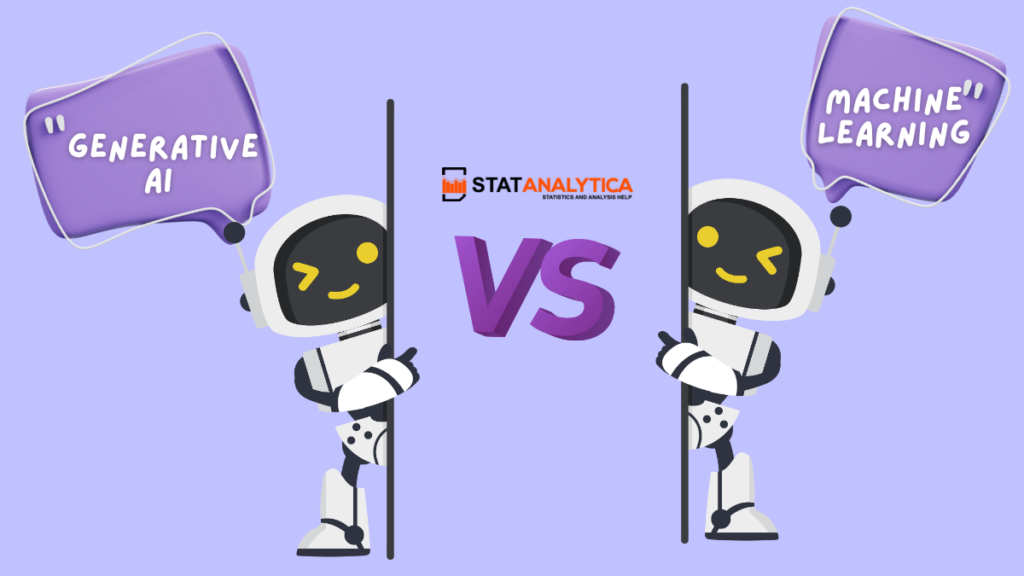In today’s tech-savvy world, you might have heard about terms like “Generative AI” and “Machine Learning.” But what do they really mean? How are they different? Let’s dive into the amazing world of artificial intelligence (AI) and explore the distinctions between these two concepts (Generative AI vs Machine Learning), keeping it simple and easy to understand, just like we’re discussing it with friends.
What is Machine Learning?
Table of Contents
Imagine you have a magical book that can learn from examples. You show pictures of cats and dogs, and the book learns to tell them apart. This magical book represents machine learning.
- Learning from Examples: In machine learning, computers learn to perform tasks without being explicitly programmed. Instead, they learn from data.
- Training Data: Just like our magical book needs pictures of cats and dogs to learn, machine learning algorithms need data to train on. This data could be anything from images to text to numbers.
- Decision Making: Once trained, machine learning algorithms can make decisions or predictions based on new, unseen data. For example, they can predict whether a given email is spam or not.
What is Generative AI?
Now, let’s add a twist to our magical book analogy. What if this book not only learns to distinguish between cats and dogs but can also create new creatures, like a cat with wings or a dog with stripes? That’s where generative AI comes into play.
- Creating New Things: Generative AI is like having a creative friend who can imagine new things based on what they’ve seen before.
- Imagination Engine: Unlike machine learning, which focuses on making decisions or predictions, generative AI focuses on creativity and generating new content, such as images, music, or even text.
- Example: Think of a generative AI model trained on pictures of flowers. It can then generate entirely new and realistic-looking flowers that it has never seen before!
Generative AI vs Machine Learning: Head To Head Comparison
| Aspect | Generative AI | Machine Learning |
| Purpose | Creating new content based on training data | Making predictions or decisions based on training data means using information from past examples to guess or decide what might happen in the future. |
| Output | Generates entirely new content | Outputs predictions or classifications based on data |
| Training | Trained on unlabeled data, focusing on underlying structure | Trained on labeled data, focusing on correct answers |
| Application | Creative fields like art, music, and design | Various fields like healthcare, finance, and self-driving cars |
| Real-World Examples | DeepArt, Magenta Project | Netflix Recommendations, Autonomous Vehicles |
Differences Between: Generative AI vs Machine Learning
Now that we have a basic understanding of both concepts, let’s compare them side by side:
Purpose
- Machine Learning: Its main purpose is to make predictions or decisions based on data.
- Generative AI: It aims to create new content or data that resembles the original training data.
Output
- Machine Learning: Outputs are typically predictions or classifications. For example, predicting whether an email is spam or not.
- Generative AI: Outputs are entirely new creations that didn’t exist in the training data. For example, generating new images of animals based on existing ones.
Training
- Machine Learning: Trained on labeled data, where each example is labeled with the correct answer.
- Generative AI: Trained on unlabeled data, focusing more on capturing the underlying structure or patterns.
Application
- Machine Learning: Widely used in various fields like healthcare, finance, and self-driving cars for tasks such as image recognition, language translation, and recommendation systems.
- Generative AI: Applied in creative fields like art, music, and design to generate new and unique content.
Real-World Examples
Let’s look at some real-world examples to better understand how these technologies are used:
- Machine Learning
- Netflix Suggestions: When Netflix picks out movies or shows it thinks you’ll enjoy, it looks at what you’ve watched before and what you seem to like, using special computer programs that learn from that information.
- Self-Driving Cars: Cars that can drive themselves use special computer programs that learn from experience to figure out things like what traffic signs mean, where people are walking, and where other cars are going.
- Generative AI
- DeepArt: This website uses smart computer tricks to turn your photos into cool artworks that look like they were painted by famous artists such as Van Gogh or Picasso.
- Magenta Project: Developed by Google, Magenta
uses generative AI to create music, art, and other creative works.
Is ChatGPT AI or Machine Learning?
- AI (Artificial Intelligence)
AI refers to machines or computer systems that can perform tasks that typically require human intelligence.
- Example: Siri, Alexa, and self-driving cars.
- Machine Learning (ML)
Machine learning is a subset of AI that enables computers to learn from data and improve over time without being explicitly programmed.
- Example: Email spam filters that learn to identify spam based on user behavior.
- ChatGPT
- ChatGPT is an AI model developed by OpenAI.
- It’s based on machine learning techniques, particularly a type of model called a transformer, trained on vast amounts of text data.
- ChatGPT uses this training to understand and generate human-like text responses to user inputs.
- Example: When you ask ChatGPT a question, it uses its training to generate a relevant response, just like a human would.
Will ML Be Replaced By Generative AI?
It’s unlikely that generative AI will completely replace machine learning (ML), but it may become an increasingly important component of ML systems. Here’s why:
- Complementary Technologies: Generative AI, like GPT models, is a type of machine learning itself. It’s a type of computer stuff that’s all about creating fresh stuff, like words, pictures, or even tunes. Therefore, it’s not so much a replacement as it is a complementary technology.
- Different Use Cases: While generative AI is excellent at creating content, traditional ML techniques are still essential for tasks like classification, regression, and reinforcement learning. ML algorithms are handy in lots of different things, like suggesting what you might like next, guessing what might happen in the future, and even more stuff we haven’t even thought of yet!
- Hybrid Approaches: Many AI systems benefit from a combination of techniques. For instance, a system might use traditional ML algorithms for classification tasks and generative AI for content generation. This mix-and-match way can use the best parts of each method.
- Continued Innovation: Both ML and generative AI are rapidly evolving fields. There will likely be advancements and breakthroughs in both areas, leading to new applications and improved performance.
Conclusion
In conclusion (generative AI vs machine learning), while both generative AI and machine learning are branches of artificial intelligence, they serve different purposes and have distinct capabilities. Machine learning focuses on making predictions or decisions based on data, while generative AI unleashes creativity by generating entirely new content.
Together, they contribute to the vast and ever-evolving landscape of AI, shaping the future in ways we’re only beginning to imagine. So, next time you hear these terms, remember our magical book analogy and the creative friend who can imagine new worlds.


